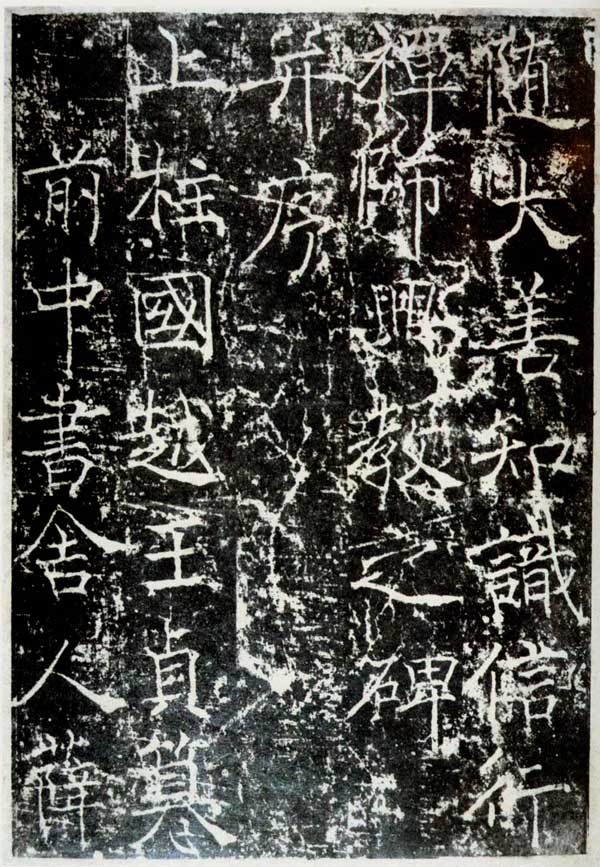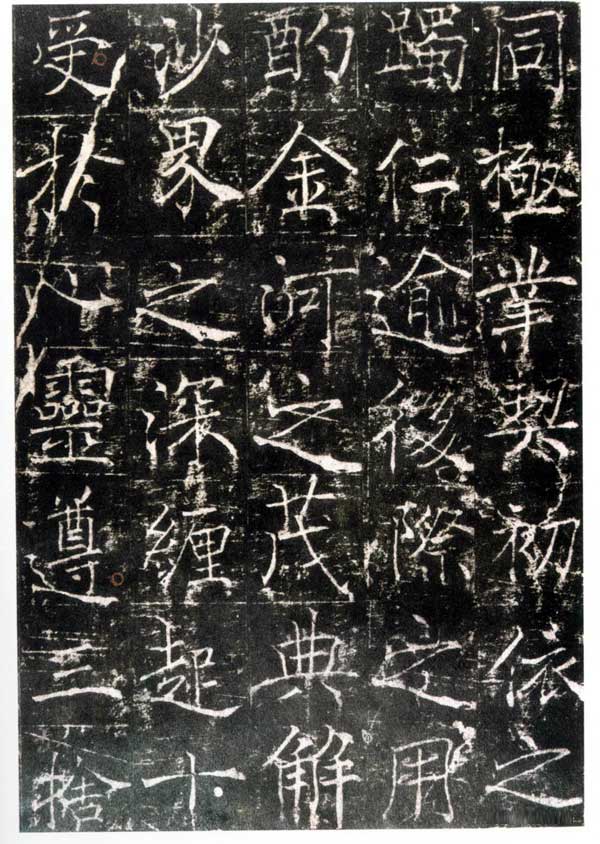Xue Ji (649-713), also known as Si Tong, was a cousin of Xue Yao and was named the grandson of Wei Zheng. In his early years, he was a classmate of Guo Zhen and Zhao Yanzhao in the Imperial Academy. Later, he was admitted to the imperial examination. In the third year of Changshou (694), he ignored the difficulties and kept the imperial examination. He once served as the magistrate of Pengshan County. In the first year of Shengong (697), he was appointed as Zhongshu Sheren and was responsible for drafting imperial edicts in Zhongshu Province. In the first month of the second year of the Holy Calendar (699), Konghe Prison was first established, and Ji summoned talented and literary people to worship him. He once served as the inspector of the "Stele of the Immortal Prince" written by Empress Wu. He sought reform from Dr. Fengchen and participated in the compilation of "Three Teachings Zhu Ying". In the second year of Jinglong (708), a bachelor of Xiuwen Guan was established, and Ji was appointed as a direct bachelor to advise the officials. At that time, the bachelor was the most selected scholar in the world. Fortunately, he traveled with the emperor, and the emperor felt something about it. The bachelor was harmonious, and people at that time honored him. Most of Ji's surviving poems were produced during the Zhongzong Dynasty, and their content may not be worth mentioning. However, their form strives for craftsmanship, and their pronunciation is particularly exquisite. They are as famous as Li Qiao, Cui Rong, and Song Zhiwen. Zhang said that he has "good gold". Beautiful jade can be used for anything." The famous "Returning to the Capital in Autumn, Ten Miles from Shaanxi Province" is elegance and elegance, combined with coquettishness, and resembles the atmosphere of the prosperous Tang Dynasty. It is especially famous by Du Fu.
Xue Ji's official career first became prominent in the Ruizong Dynasty. According to historical records, when Ruizong was in the feudal dynasty, he paid attention to primary school, especially calligraphy. He especially appreciated Xue Ji's talents in calligraphy, painting and erudite appreciation. He married his fifth daughter, the princess of Xianyuan County (later canonized princess, Princess of Jin and Liang Kingdom) to Xue Ji. Xue Boyang, Ji's son, became his son and daughter's in-laws. After receiving the throne from Zen, he was even more valued, and he was worshiped as the Minister of Zhongshu and participated in political affairs. Xun Yin fought with Zhongshu Ling Zhong Shaojing for power and changed his position to Zuo Sanqi Changshi. Later, he served as Minister of the Ministry of Industry and the Ministry of Rites, and became the Crown Prince Shaobao, known as "Xue Shaobao" in history. He was also awarded the title of Duke of Jin for his merits. Ruizong took him as his in-law, and often invited him to and from the palace to participate in government affairs. He was sometimes known as the most merciful minister. In the first year of Kaiyuan (713), Dou Huaizhen was executed. Ji knew of his plan and died in ten thousand years of imprisonment at the age of sixty-five.
Xue Ji had many talents and was good at painting. He was especially famous for his painting of cranes. , upright as an elder. Such great ambitions are nothing but fresh and new. Thousands of miles without strength, the group travels in the forest to meet the gods. The majestic and white phoenix is not the neighbor of the barn... The red sky has real bones, and it is shameful to drink dirt. Chi Lv. Wherever you go, no one can tame them." "Xuanhe Painting Book" also said that Xue Ji painted cranes, and he was able to capture their spirit, which should be attributed to his exquisiteness through the ages. One commentator said: "There are many people who raise cranes in the world... ...However, there are very few people who are good at painting cranes. The shallowness and depth of the crown, the lightness of the scorn, the length of the beak, the thinness and largeness of the shanks, and the height of the knees, there is not even one person who can draw from life. And as for his excellence, Female, it is particularly difficult to distinguish between north and south. Although the hand trumpet is good at painting, the painting of a crane with its claws touching the ground is also lost. Therefore, (Xue) Ji's use of this is quite wonderful, and it is appropriate to be named in ancient and modern times. ." "Therefore it is said that the crane must be called Ji, hence the name." Yun. Famous poets of the Tang Dynasty, such as Li Bai and Zhiwen of the Song Dynasty, also wrote poems praising it.
Ji was born in Imperial College and studied calligraphy every day. He was influenced by the calligraphy style of Yu and Chu at that time. As he grew older, he was taught by his uncle Wei Shuyu. There are many handwritten notes and notes by Yu Shinan, Chu Suiliang and others at home. Ji imitated them one by one and worked tirelessly in his poor years. Later, he was enshrined in the inner court and obtained the famous relics of the Wei and Jin Dynasties such as Zhong, Zhang, and the two kings stored in Guanmi Mansion. He admired and copied them, and then he and his middle cousin Wei Hua became famous all over the world with their books. , Chu, followed by Xue and Wei." Later, when discussing calligraphers, he went to Wei to supplement Ou (Ouyang Xun), and Li Ou, Yu, Chu and Xue were the "four calligraphers of the early Tang Dynasty". At that time, it was said that "you can get Xue by buying Chu without losing its integrity." However, upon closer inspection, there are still small differences between him and Chu. He did not further develop the graceful and graceful style of Chu's late period, but worked hard on "sparing, thinning and vigorous training", so that he could "knot the characters smoothly and be a separate family."
Xue Jixing and regular script first appeared in the "Shuguan" written by Zhang Huaiguan in the middle period of Kaiyuan Dynasty. It was incorporated into Nengpin, and a biography said: "Chu Gong learned calligraphy, especially beautiful and beautiful, and he has half the skin and flesh of his teacher. It can be said that Henan Du Fu once saw the three characters on the forehead of his Puzan Temple, with vigorous writing style. There is a poem "Viewing the Painting and Calligraphy Wall of Xue Shaobao" that praises: "Looking up at the hanging dew posture, it does not collapse or collapse. . The three characters of "Yu Yu" are intertwined with dragons." Dong Kui's "Guangchuan Book Postscript" inherited the Tang Dynasty and regarded him as the direct descendant of the Chu family. There is a comment on the seventh volume of the book: "Xue Ji wrote Ou, Yu, Chu, Lu (Lu Jianzhi) left ink well prepared, so it can be used as a basis for the law. However, his teacher is of the same blood, so he is close to Chu. As for the thin brush, the knots are clear, and it is a separate family." "The thin brush" , out of deliberateness, is the style of the era, not only Xue Ji is like this, but his cousin Xue Yao is even less rich. Ji's calligraphy comes from the Chu family. Although there are novelties at times that can distinguish him from the wind god, in the end, because it "exceeds the effectiveness of Shi Shu and is inferior to the cover of Sui Zhu", he cannot fully surpass the scale of Chu family and stand alone. Among the "Four Schools of the Early Tang Dynasty", they are actually inferior. Therefore, those who attached Ji Ou, Yu, and Chu were trying to get an even number! The surviving "Xinxing Zen Master Monument" was written by Yue Wangzhen, in the second year of Shenlong. (706) Standing in Chang'an is his masterpiece.
Appreciation of works: "Monument of Zen Master Xinxing"


"The Monument of Zen Master Xinxing" is Xue Ji's representative work. It is clear, vigorous, and insightful, and has the legacy of Chu Suiliang's "The Monument of Yique Shrine". At the same time, his lean style also influenced Liu Gongquan in the late Tang Dynasty and Emperor Huizong in the Song Dynasty. This monument was erected in August of the second year of Shenlong in the Tang Dynasty (706). The original stone has been lost for a long time, and now only the cut and framed copy from He Shao's tomb in the Qing Dynasty has been passed down to the world. It is said to have flowed into Japan.








